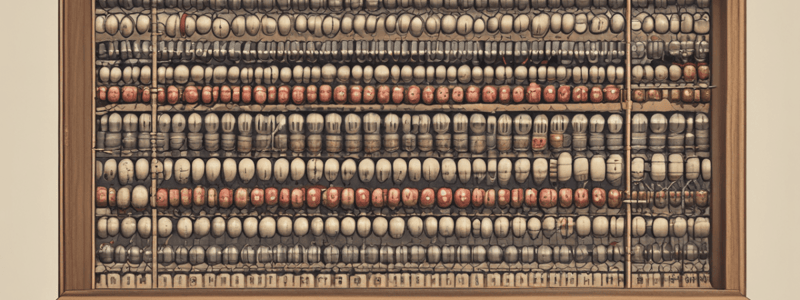Podcast
Questions and Answers
What was the primary function of early mechanical computing devices?
What was the primary function of early mechanical computing devices?
- To store large amounts of data
- To communicate with other devices
- To assist humans with simple arithmetic (correct)
- To perform complex calculations
What is the primary component of an abacus?
What is the primary component of an abacus?
- Rods and beads (correct)
- Wheels and pulleys
- Circuits and memory
- Electricity and plugs
What is the significance of the rows on an abacus?
What is the significance of the rows on an abacus?
- Each row represents a different mathematical operation
- Each row represents a different type of calculation
- Each row represents a power of ten (correct)
- Each row represents a different type of data
Who is credited with designing a calculating device that operated with wheels and pulleys?
Who is credited with designing a calculating device that operated with wheels and pulleys?
What was the purpose of John Napier's device?
What was the purpose of John Napier's device?
What was the name of John Napier's device?
What was the name of John Napier's device?
What was the significance of Leonardo da Vinci's sketches?
What was the significance of Leonardo da Vinci's sketches?
What were the earliest computing devices?
What were the earliest computing devices?
What was the significance of the Babylonian, Chinese, Japanese, and Russian civilizations in the history of computing devices?
What was the significance of the Babylonian, Chinese, Japanese, and Russian civilizations in the history of computing devices?
What was the primary material used in the construction of early computing devices?
What was the primary material used in the construction of early computing devices?
Flashcards are hidden until you start studying
Study Notes
History of Computing Devices
- Humans have used tools for computations and calculations since ancient times.
- Primitive devices like fingers, stones, and sticks were used for counting and keeping track of livestock.
Early Computing Devices
- The first computing devices were mechanical, not electronic, and did not have plugs, circuits, memory, or use electricity.
- Their primary function was to assist humans with simple arithmetic.
Abacus
- An abacus is a frame with rods and beads that can be moved for counting purposes.
- The exact history of the abacus is unknown, but it was used by the Babylonian, Chinese, Japanese, and Russian civilizations.
- Each row on the abacus represents a power of ten with ten beads on each row.
- The abacus had the following rows: tens, hundreds, thousands, 10 thousands, 100 thousands, millions, 10 millions, 100 millions, billions, and ones.
Leonardo da Vinci's Calculating Device
- Leonardo da Vinci designed a calculating device to perform basic arithmetic in approximately 1500 A.D.
- The device operated with wheels and pulleys.
- Da Vinci's sketches were complete and correct enough for modern engineers to build a calculator based on them.
Napier's Bones
- John Napier created a device called "Napier's Bones" or "Napier's Rods" in 1614.
- The device used rods to perform multiplication of any number by a number 2 through 9.
- For example, it could be used to calculate 7 x 846.
Studying That Suits You
Use AI to generate personalized quizzes and flashcards to suit your learning preferences.




